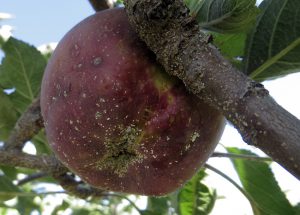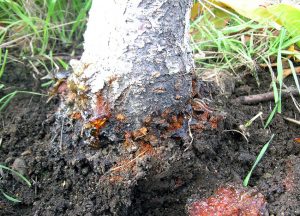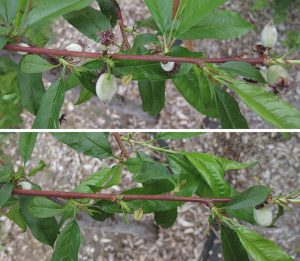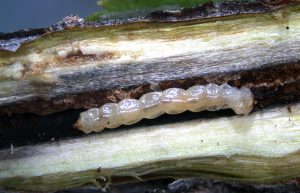In this Issue
- San Jose scale: treatment dates coming up
- Peach twig borer: spray date table provided as pdf link
- Greater peachtree borer: spray dates provided for many counties
- Thinning peaches
- Western cherry fruit fly: treat when fruit turns salmon-blush color
- Berries: rose stem girdler on raspberry, currant, black raspberry
APPLE, PEAR
Codling Moth
Stay tuned to the next newsletter on Wednesday, June 8, with an update for codling moth dates.
San Jose Scale
Treat crawlers soon

San Jose scale is an armored scale (immobile insect with hard covering) that mostly occurs on apple. It can be found feeding on bark, and when populations are high, it appears on fruit as small pepper-flake spots with a purple halo. The scales are often difficult to see with the naked eye and require magnification.
We always recommend a dormant oil spray to help knock down the scale population. Ideally, the oil will smother the overwintering nymphs, whose protective “covering” is not as developed as adults. Overwintering adults will survive the dormant oil spray, and young nymphs laid by mated females (called crawlers) will need to be treated. Crawlers walk or are windblown to new sites to settle on twigs or fruit, insert their mouthparts, and feed for the remainder of their lives.
- Cache, Summit, Uinta, Wasatch counties: June 15 – 19
- Iron County: June 6 – 9
- Wasatch Front warmer areas and Carbon County: June 8 – 11
- Wasatch Front cooler areas: June 15 – 18
Treatment
- Residential growers can use insecticidal soap+1% oil, neem oil, GardenTech Sevin, Spectracide Triazicide, or Monterey Bug-Buster II.
- In addition, the trunk can be scrubbed to remove the scale bodies (best done in fall or spring)
- Options for commercial growers: click here.
PEACH/NECTARINE, APRICOT, PLUM
Peach Twig Borer
Treatment dates for peach, nectarine, and apricot
Click here for a pdf table of treatment dates (opens in new tab) for protection of shoots and fruit against peach twig borer.
Peach twig borer is the “worm in the peach”. It is a somewhat sporadic pest in Utah, where some locations have a low enough population that trees do not need to be treated.
In spring when peach and apricot fruits are still hard, peach twig borer larvae feeds within succulent twigs. You may notice wilted over twigs and these are called shoot strikes. Later in the season, when twigs become hardened off and unpalatable, larvae feed inside the fruit.
If peach twig borer is sporadic, you can get away with a single (or no) application for each generation (up to 2 well-timed sprays). Otherwise, one spray is required for first generation, and multiple sprays may be required for second generation (when the fruit is susceptible).
Treatment
Residential trees, Conventional:
- GardenTech Sevin; Bonide Fruit Tree Spray Guard; Spectracide Triazicide, Monterey Bug-Buster II (all pyrethroids): Lasts 14 days
Residential trees, Organic:
- Green Light; Gardens Alive Bull’s Eye; Monterey; Bonide Captain Jack’s (spinosad): Lasts 7 days
- Ortho Fruit Spray; Fertilome Fruit Tree Spray; Worry-free Insecticide (pyrethrin): Lasts 5 days
- Safer BioNEEM (azadirachtin; if you can find it): Lasts 7 to 10 days
Commercial
- Commercial growers, click here.
Greater Peachtree Borer

Protect lower trunks of peach, plum
Greater peachtree borer moths lay eggs on the lower 12” of peach trunk or on nearby soil, and larvae bore through the bark and feed on the cambium. Larvae pupate the following spring, and when they emerge, they sometimes leave their pupal case stuck in the tree.
Only the lower 12″ of the trunk (down to soil line) and any exposed roots need to be protected from peachtree borer. It is also very important to remove all weeds and grass away from the trunks because the moths prefer the dark, moist egg-laying environment.
The ranges of a predicted first treatment date (or date where mating disruption should be hung) are shown below.
- Cache, Sanpete, Summit, Uinta, Wasatch counties: July 3 – 5
- Iron County: June 16 – 19
- Wasatch Front warmer areas and Carbon County: June 19 – 23
- Wasatch Front cooler areas: June 24 – 27
- Grand, Kane,Wayne counties: June 6 – 10
Treatment
Female moths are actively laying eggs all summer long, so keep the trunk protected. Peach trees younger than 5 years are the most vulnerable. The last application should be on Sept 15.
- Residential growers – the organic option is a product containing spinosad or pyrethrin (apply every 10 days); otherwise, use a product containing permethrin, such as Hi Yield Garden & Farm Insect Control or Hi Yield Indoor/Outdoor (apply once per month)
- Options for commercial growers who have not used mating disruption: click here.
Thinning Peaches (Residential Information)

Apple trees should already be thinned (down to a single apple per cluster, and 6 inches between fruits).
It is also time (or past time in some areas) to thin peaches (4 weeks after full bloom, or when peaches are the size of a robin’s egg). Peach trees set far more fruit than the tree can carry to harvest. Thinning the extra fruit is very important not only to get a good crop of fruit this year, but to get a decent crop next year.
- Excess fruit that remains too long on the tree will impact fruit size, formation of flower buds and crop potential for the following year, and overall tree health. An overload of peaches greatly reduces the tree’s carbohydrate reserves and can also affect the tree’s ability to withstand disease and winter injury.
- Branch breakage can also occur from the weight of too many peaches.
- Proper thinning ensures an even production of flower buds from year to year and provides larger fruit size. Although fruit will naturally drop from the tree (“June drop”), the amount is insufficient to assure optimal fruit size. Natural drops typically stem from unfertilized seed, cold injury, competition between fruit, or excessive shading.
Remove fruit by hand-twisting them off, or on taller trees, hitting unwanted fruit with children’s plastic bats, rubber hoses, or other soft object.
When thinning, pick off the smallest fruits as well as any that are mis-shaped or damaged. Then adequately space the remaining fruits to 4 to 6 inches apart. A moderate-sized peach tree should only produce 100 to 150 fruits on the entire tree.
CHERRY
Western Cherry Fruit Fly
Start treating when fruits in sunniest location color to a salmon blush
The time to start treating to prevent “worms in the cherry” is based on the fruit development of your own tree. Fruit color will go from green to yellow, and then quickly develop a rosy blush. Once that rosy blush forms, then the female flies are able to penetrate the fruit skin and lay eggs inside. Therefore, watch your fruit and start spraying when fruits in the sunniest location (usually at the top of the tree or on the south side) turn a salmon-blush color.
Western cherry fruit fly is a serious pest of tart and sweet cherries. Please keep in mind that any commercial growers’ crop can be rejected by the processing plant if worms are detected. Therefore, if you have trees that are adjacent to commercial orchards, it is important they are treated for cherry fruit fly, or removed to preserve the livelihood of our farmers.
Treatment
Start treatment at salmon-blush color and continue, with the last spray providing protection until harvest.
- Residential, Conventional:
- Malathion (malathion): every 7 days
- Bonide Fruit Tree Spray (carbaryl): every 14 days
- GardenTech Sevin; Spectracide Triazicide; Monterey Bug Buster II; Bonide Fruit Tree Guard (pyrethroids): every 14 days
- Residential, Organic:
- Fertilome; Gardens Alive; Bull’s Eye; Captain Jack’s; Monterey (spinosad): every 7 days
- Safer BioNEEM (if you can find it; azadirachtin): every 7 to 10 days
- Commercial growers, click here
BERRIES
Rose Stem Girdler

A major pest of raspberries is the rose stem girdler. This insect can also attack currants, black raspberry, and roses. The adult is a shiny, bronze-colored beetle. Adults are starting activity now and will be laying eggs on canes.
Females lay eggs near the base of the canes, and the larvae hatch and tunnel into the cane tissue. Canes may have swellings at the feeding sites, and infested canes may break at weak areas later in the season.
Treatment
The best treatment option is to remove and destroy infested canes late in the season and over the winter. There are a few insecticides that can be used to kill the eggs and newly hatched larvae, but use caution when spraying flowering plants by treating at dawn or dusk only to protect pollinators, or ideally, do not spray plants in bloom.
- Options for commercial and residential include: malathion; pyrethrin (Pyrellin EC*, Bonide Liquid Pyrethrin Spray and more); products containing a pyrethroid (Spectracide Triazicide, GardenTech Sevin, Monterey Bug Buster II, Asana, Mustang, Warrior).
- Treat two or three times, spaced 7 to 14 days apart (depending on material used) and target the base of the canes.
